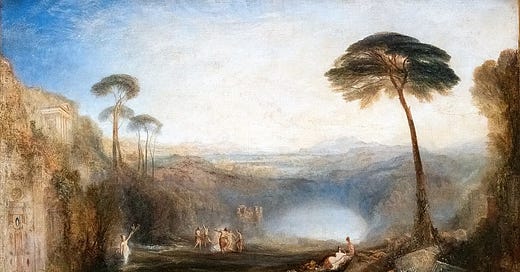“And all the trees of the field shall clap their hands.”
– Isaiah 55:12
This week, I finally finished reading The Golden Bough, James George Frazer’s sweeping and influential study of folklore and ritual. (The Oxford World’s Classics abridgment just exceeds 800 pages; I have been chipping away at it since January.) Though Frazer’s conclusions can be dubious, the sheer breadth of his work is remarkable; The Golden Bough ranges freely across centuries, continents, and cultures to adduce hundreds of examples of human beliefs and rites.
Frazer’s aim in The Golden Bough is to tie this unwieldy mass of material into one cohesive whole by finding a common basis underlying all of the different belief systems he discusses. In this way, his project is similar to those of the early 1900s’ other big names in comparative religion. Carl Jung sought to find a psychological basis underlying the world’s religions and came up with the ideas of archetypes and the collective unconscious; Joseph Campbell sought to find narrative commonalities and came up with the idea of the monomyth. Frazer is a skeptic who favors material, rational, and naturalistic explanations. His hypothesis is that the world’s religions all have their basis in natural phenomena, and that their rituals are derived from a basic misunderstanding of cause and effect. According to Frazer, primitive man imagines himself (or his gods) to have a greater ability to manipulate the natural world than he actually does; his rites are simply ways to bring about a desired result in the natural world (or persuade his gods to do so). Thus, science is simply a more rational and effective development of magic: a means of manipulating the natural world that is actually efficacious because it is based on a more accurate observation of the way that world works.
Reading The Golden Bough, I was struck again and again by the correlations between Christianity and the primitive pagan belief systems that Frazer cites. Based on Frazer’s research, it would seem that the ritual killing of a god in human form has been a central feature of the vast majority of the world’s religions since time immemorial. Sometimes the dying god is linked to a tree, and his death and rebirth correspond to the seasonal death and rebirth of vegetation. Sometimes the god becomes, by his death, a source of sustenance for his followers, who eat his body and drink his blood. And sometimes the dying god is conceived of as a scapegoat who takes the evils of the community on himself and removes them from his people by his death. All three of these interpretations resonate with the central event of the Christian story, the crucifixion and resurrection of Christ: Jesus dies on a tree for the life of the world, gives His body and blood to sustain His followers, and takes away their sins by His death.
Frazer is not unaware of these similarities, and he offers an explanation for them that fits his hypothesis, suggesting a common origin that is natural rather than supernatural. He posits that the Christian religion is merely a more civilized refinement of the primitive pagan religions that predate it. However, Frazer himself acknowledges that the evidence admits of another interpretation:
“In the great army of martyrs who in many ages and in many lands, not Asia only, have died a cruel death in the character of gods, the devout Christian will doubtless discern types and forerunners of the coming Saviour – stars that heralded in the morning sky the advent of the Sun of Righteousness – earthen vessels wherein it pleased the divine wisdom to set before hungering souls the bread of heaven. The sceptic, on the other hand, with equal confidence, will reduce Jesus of Nazareth to the level of a multitude of other victims of a barbarous superstition, and will see in him no more than a moral teacher, whom the fortunate accident of his execution invested with the crown, not merely of a martyr, but of a god. The divergence between these two views is wide and deep. Which of them is the truer and will in the end prevail?” (676)
It is clear where Frazer’s own sympathies lie, but it seems to me that at least one notable Christian author has indeed taken his evidence and drawn the opposite conclusion from it. I think that The Golden Bough haunts quite a lot of C.S. Lewis’ writing (especially his essay “Is Theology Poetry?” and his novel Till We Have Faces). One of the more direct evocations, I would say, comes in Book II of Mere Christianity, where Lewis writes about the three primary ways God made Himself known to man before the coming of Christ. The second of the three could be a description of the content of The Golden Bough:
“He sent the human race what I call good dreams: I mean those queer stories scattered all through the heathen religions about a god who dies and comes back to life again and, by his death, has somehow given new life to men.” (50)
All of this is to say that the pervasiveness of the story of the dying and rising god across the world’s religions can be seen as a proof against Christianity or a proof in its favor. The Golden Bough presents a hundred ambiguous signposts, which could be read as pointing in one direction or the other. Perhaps the story of the dying god is just an imaginative misunderstanding, an anthropomorphized gloss on the seasonal death and rebirth of the trees. Or perhaps the “true myth” of Christianity is simply so deeply woven into the fabric of reality that we find traces of it everywhere we look, and even the trees bear witness to it.




